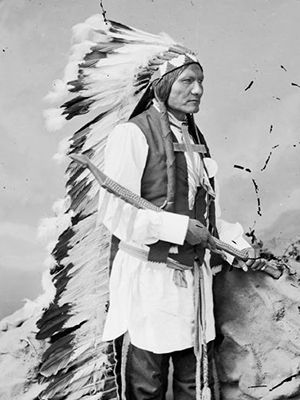He Dog
He Dog, Šúŋka Bloká was a lifelong friend of Crazy Horse. Born in the spring of 1840 on the headwaters of the Cheyenne River near the Black Hills he was the son of a headman named Black Stone and his wife, Blue Clay, was a sister of Red Cloud.
He Dog and his brothers formed a small Oglala Lakota band known as the Cankahuhan or Soreback Band that was closely associated with Red Cloud’s Bad Face Band of Oglala. As he achieved warrior status, participating in many fights with neighboring tribes, he eventually became a leader of Red Cloud’s Bad Face band. He Dog participated in the Great Sioux War of 1876-77.
After the treaty commission failed to persuade the Lakota to give up the Black Hills, the President had an ultimatum sent in January 1876 to the northern bands to come into the agencies or be forced in by the army. He Dog was encamped with the Soreback band on the Tongue River when the message was delivered. He Dog’s brother, Short Bull, later recalled that the majority of the northern Oglala resolved to head into the Red Cloud Agency in the spring, after their last big buffalo hunt.
In March 1876, He Dog married a young woman named Rock (Inyan) and with part of the Soreback Band, stopped briefly with the Northern Cheyenne encamped on the Powder River in Wyoming Territory. On the morning of March 17, 1876, a column of troops under Colonel Joseph J. Reynolds attacked. “This attack was the turning point of the situation,” Short Bull later recalled. “If it had not been for that attack by Crook on Powder River, we would have come into the agency that spring, and there would have been no Sioux war.”
During the summer of 1876, He Dog participated in the Battle of the Rosebud and the Battle of the Little Bighorn. He also fought at Slim Buttes in September 1876 and Wolf Mountain in January 1877. He finally surrendered at the Red Cloud Agency with Crazy Horse in May 1877. Following the killing of Crazy Horse, He Dog accompanied the Oglala to Washington, D.C. as a delegate to meet the President.
He Dog and other members of the Soreback Band fled the Red Cloud Agency after its removal to the Missouri River during the winter of 1877-78. Crossing into Canada, they joined Sitting Bull in exile for the next two years. Most of the northern Oglala surrendered at Fort Keogh in 1880 and were then transferred to the Standing Rock Agency in the summer of 1881. He Dog and the northern Oglala were finally transferred to the Pine Ridge Reservation to join their relatives in the spring of 1882.
He Dog lived the remainder of his life on the Pine Ridge Reservation. He served as a respected Indian judge and later in life, was interviewed by a number of historians, including Walter Mason Camp, Eleanor Hinman, and Mari Sandoz. He died in 1936 between the ages of 95 or 96.
Sources
Dockstader, Frederick J., Great North American Indians: Profiles in Life and Leadership, Litton Education Publishing, Inc., 1977.
